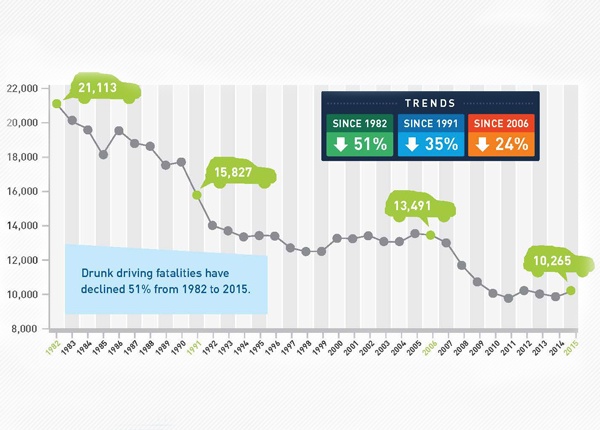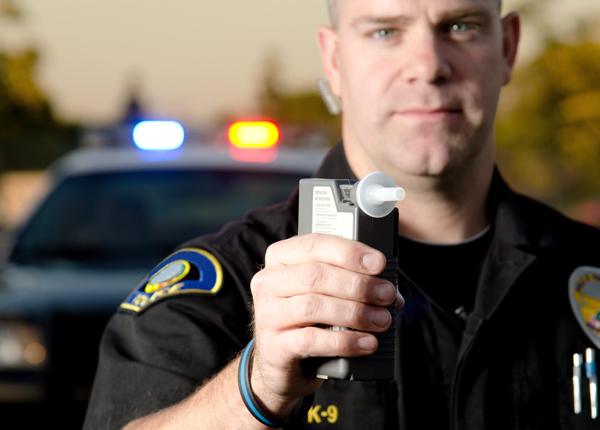
DUI & DWI Statistics: The Human Cost of Impaired & Drunk Driving
Updated Dec. 25, 2020In 2017, drunk drivers with a BAC of 0.08% were responsible for the deaths of 10,784 people around the United States. 68% of these fatalities involved a driver with a BAC of 0.15% or higher. Despite the progress that has been made since The Minimum Drinking Age Act and the lowering of the legal drink driving limit, our country still has a long way to go. Approximately every 48 minutes another person dies needlessly at the hands of an alcohol-impaired driver.
For the past couple of decades, around one-third of all traffic-related fatalities occurring each year are caused by alcohol impairment. That amounts to hundreds of thousands of totally preventable deaths and millions of devastated lives, as people lose friends, husbands, wives, children, parents and siblings.
Alcohol-impaired deaths by state
State by state, the proportion of traffic-related deaths that are caused by alcohol impairment roughly reflects the national standard. In states where alcohol awareness has some catching up to do, the percentage of traffic fatalities caused by drunk drivers is much higher. These figures from 2017 show the states with the highest death toll.
- Connecticut: 43% (120 deaths)
- North Dakota: 40% (46 deaths)
- Rhode Island: 41% (34 deaths)
- Hawaii: 39% (42 deaths)
- Texas: 39% (1468 deaths)
- Wyoming: 36% (44 deaths)
- California: 31% (1120 deaths)
Shocking though these figures are, they still do not reflect the magnitude of our nation’s drunk-driving epidemic. The Federal Bureau of Investigation estimates that in 2016, a staggering 1,017,808 drivers were arrested for driving under the influence of alcohol or drugs. Even more frighteningly, it is thought that the average drunk driver has driven while impaired by alcohol around 80 times prior to their first arrest. Law enforcement agencies simply cannot combat the problem alone. If the human cost of alcohol-impaired driving is to be lowered, individual drivers must be educated about the risks of drinking and driving and choose not to get behind the wheel while impaired.
Fatal collision risk
Studies have shown us that driving with alcohol in your system significantly increases the risk of being involved in a fatal collision. The higher the BAC, the greater the risk:
- а BAC of 0.05% increases fatal collision risk five times.
- а BAC of 0.08% increases fatal collision risk nine times.
- а BAC of 0.15% increases fatal collision risk 20 times.
“Involved in a fatal collision” does not necessarily mean that the drivers themselves were killed, though this is often the case. Tragically for everybody involved, alcohol-impaired collisions frequently claim innocent victims. The people who die in these incidents may be pedestrians, other car drivers, or passengers who are riding with the intoxicated driver.
Of the 10,784 alcohol-impaired driving fatalities in 2017:
- 61% of fatalities were the impaired driver themselves.
- 28% of fatalities were vehicle occupants (14% of which were passengers riding with the intoxicated driver).
- 11% of fatalities were non-occupants such as pedestrians and cyclists.
If you cause a fatal traffic accident while impaired by alcohol, there is a very strong chance that you will either cut your own life short or rob somebody close to you of theirs. Even if the person you kill is a stranger on the street, you will have to carry the burden of their death for the rest of your life.
Who pays the price?
Modern cars are built with advanced safety systems including seat belts, front and rear crumple zones and airbags to protect vehicle occupants during a collision. While these measures go along way to prevent serious injury and death in low to moderate speed crashes, they will not save you when you’re hurtling along the roadway at 60, 70 or 80 mph. Alcohol impairment often leads to driving at unsafe speeds and severely limits vehicle control skills. If you get into a collision while drunk at the wheel, it is likely to be a serious one.
Furthermore, these safety systems do nothing to protect people outside the vehicle. Sadly, it is often the most vulnerable road users who pay the price for somebody else’s drunk-driving mistake. Motorcyclists, cyclists and pedestrians do not stand a chance against an alcohol-impaired motorist in a 3,000 lb metal box. Of the 10,497 alcohol-related traffic fatalities which occurred in 2016:
- 1,600 were motorcyclists
- 807 were pedestrians
- 91 were cyclists
When you get into the driver’s seat, remember that it is not only your safety and the safety of other motorists you must be concerned with. On your journey, you will likely encounter pedestrians, cyclists and other vulnerable road users who do not have an enclosed vehicle to protect them in the event of a collision.
People who work on or nearby the roadway are extremely vulnerable to alcohol and drug-impaired drivers and are often seriously injured, or killed, in impaired driving collisions. For instance:
- Police officers and traffic cops are often struck when walking between vehicles stopped at the side of the road.
- Construction workers spend long hours carrying out work on the road, or near the roadside. The high-visibility vests, barriers and warning signs designed to protect them are often ineffective against drunk drivers.
- Traffic control personnel and crossing guards must stand in the center of the road to direct traffic.
- Paramedics often give emergency medical aid to crash victims on or near the roadway.
Remember that you are far more likely to collide with pedestrians and road workers while under the influence of drugs or alcohol, as you will be less aware of your surroundings and may not see them until it is too late. In addition, your reaction time will be considerably extended. Even if you do spot a pedestrian up ahead, you may not be able to slow the vehicle in time to avoid hitting them.
Vulnerable groups
According to the Center for Disease Control (CDC) drivers with previous DUI or DWI convictions, young people and motorcyclists are the most likely to die in alcohol-impaired traffic accidents. Children aged 14 and under also fall victim to drunk drivers quite frequently. In 2017, 220 children were killed in drunk driving collisions. Tragically, many of these children were being cared for by the intoxicated driver who caused the crash:
- 54% were riding in the vehicle with the intoxicated driver.
- 32% were occupants of other vehicles.
- 13% were non-occupants (pedestrians, cyclists, etc)
People aged 21 to 24 are among the most likely to be killed in a drunk driving collision, as they are the most likely to drive while intoxicated. Males are also substantially more at risk of dying in an alcohol-impaired crash as compared to females, as figures suggest they are twice as likely to get behind the wheel while impaired by alcohol.
The cost of drug-impaired driving
The true impact of drug-impaired driving is not yet fully understood. The National Highway Traffic Safety Administration state that less than 50% of drivers involved in fatal collisions are tested for drugs. Of those that are tested, around 30% are found to have drugs in their system, which works out as 6,000 drivers each year. However, the actual number of drivers involved in fatal crashes who are impaired by drugs is likely to be much higher than this, because:
- Many drivers are not tested for drugs at all.
- Many legal and illegal drugs will only show up in a blood test.
- It is impossible to test for every potentially intoxicating substance in each instance, as there are so many.
In two-thirds of fatal collisions that do involve drug impairment, the impaired driver is among the fatalities. It seems that driving under the influence of drugs dramatically increases your chances of dying as compared to driving under the influence of alcohol alone. Every year, around 4,000 drivers with drugs in their system are killed in collisions. This is likely because drug-impaired crashes are usually severe and frequently involve high-speeds, complete loss of control and off-road collisions.
Injury and property damage
Death is not the only negative outcome of a drunk driving incident. The National Highway Traffic Safety Administration (NHTSA) reports that every day, approximately 800 people are injured in drunk driving collisions. That amounts to 300,000 every year, or one person every two minutes. This figure includes everything from minor bumps and cuts to debilitating injuries, such as brain damage, loss of limbs, facial disfigurement and paralysis. Many people who are fortunate enough not to die in an alcohol-impaired collision go on to suffer physical and/or mental disabilities for the rest of their lives.
Even drunk driving collisions during which nobody was injured can permanently change the course of a person’s life. People involved in the crash may suffer from mental health problems such as anxiety and post-traumatic stress disorder (PTSD), which impact their happiness and stop them from living life to the full. If you are the driver responsible for the alcohol-fueled collision, you will likely have to contend with:
- Paying court costs, fines and victim compensation
- Loss of your driver’s license
- Other penalties, which may include jail time
If you have injured another person or caused property damage as a result of your irresponsible actions, you may end up financially burdened for the rest of your life. Without a license, you could lose your job. You may even find your college applications are rejected or you are kicked out of school. That single foolish decision to get into the driver’s seat while intoxicated could easily ruin the rest of your life, even if nobody is injured or killed.
The economic cost of drunk driving
Drunk driving is an expensive problem. According to Mothers Against Drunk Driving (MADD), alcohol-impaired driving costs the United States around $199 billion every year. This estimated economic cost includes:
- Medical costs
- Property damage
- Emergency medical services
- Legal expenses
- Lost productivity
- Congestion costs
- Insurance administration
These are easily measurable and tangible costs incurred by alcohol-impaired driving. While nearly $200 billion seems an enormous amount of money, this figure falls short of representing the overall quality-of-life and happiness losses that our country suffers as a result of drunk driving. When the societal impact of emotional trauma, serious injury and loss of life are taken into account, the annual economic cost of alcohol-impaired driving is in excess of $800 billion.




